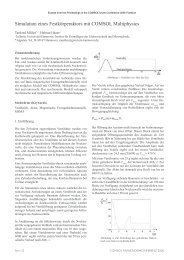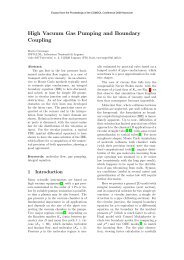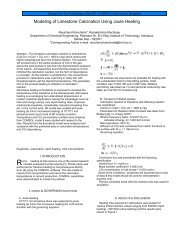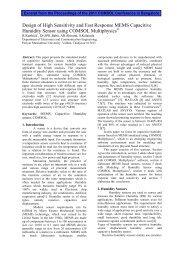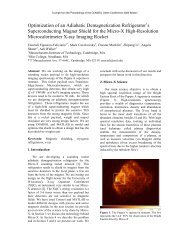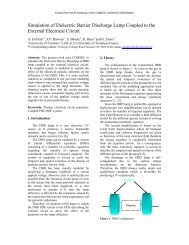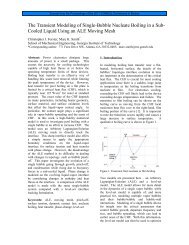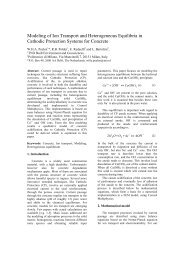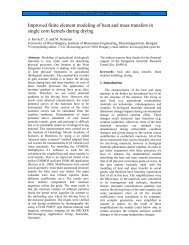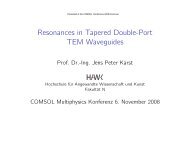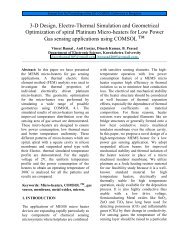Download Paper - COMSOL.com
Download Paper - COMSOL.com
Download Paper - COMSOL.com
Create successful ePaper yourself
Turn your PDF publications into a flip-book with our unique Google optimized e-Paper software.
and [13] for the same rotor configurations, thus<br />
validating, for a straight blade, the formulation<br />
implemented in Comsol Multiphysics. These results<br />
demonstrate that the inclusion of aerodynamic<br />
effects introduces dampings in the blade<br />
dynamic behavior that are strongly dependent<br />
on the blade pitch (both directly and via the stationary<br />
trim configuration that is perturbed).<br />
Nondimensional tip displacements and rotations<br />
Nondimensional eigenfrequencies<br />
0.1<br />
0.08<br />
0.06<br />
0.04<br />
0.02<br />
0<br />
-0.02<br />
Ref. [4]<br />
Ref. [13]<br />
Present model<br />
Flap<br />
-0.04<br />
0 0.05 0.1 0.15 0.2 0.25 0.3<br />
Collective pith angle [rad]<br />
Torsion<br />
Lag<br />
Figure 6: Equilibrium blade tip deflections.<br />
5<br />
4.5<br />
4<br />
3.5<br />
3<br />
2.5<br />
2<br />
1.5<br />
1<br />
Ref. [4]<br />
Ref. [13]<br />
Present model<br />
0.5<br />
0 0.05 0.1 0.15 0.2 0.25 0.3 0.35 0.4 0.45<br />
collective pith angle [rad]<br />
Torsion<br />
Lag<br />
Flap<br />
Figure 7: Aeroelastic eigenfrequencies for straight<br />
blade.<br />
Then, the blade described in Ref. [13] is<br />
considered for the analysis on the aeroelastic<br />
stability effects due to tip sweep and anhedral<br />
angles. In particular, the tip 10% of the blade is<br />
subject to sweep and anhedral distortion. Figures<br />
9 and 10 present the results of the aeroelastic<br />
eigenanalysis for the baseline blade given<br />
in Ref. [13] for several values of the sweep angle,<br />
respectively in terms of eigenfrequencies and<br />
Nondimensional dampings<br />
0<br />
-0.05<br />
-0.1<br />
-0.15<br />
-0.2<br />
-0.25<br />
-0.3<br />
-0.35<br />
Ref. [4]<br />
Ref. [13]<br />
Present model<br />
-0.4<br />
-0.05 0 0.05 0.1 0.15 0.2 0.25 0.3 0.35 0.4 0.45<br />
Collective pith angle [rad]<br />
Lag<br />
Flap<br />
Torsion<br />
Figure 8: Aeroelastic dampings for straight blade.<br />
dampings. Next, Figs. 11 and 12 show the<br />
same kind of results concerning a modified blade<br />
where structural data have been tailored so as<br />
to cause a strong coupling between first-torsion<br />
and second-flap modes. The <strong>com</strong>parison between<br />
the results presentd in Ref. [13] and those from<br />
the formulation implemented in Comsol Multiphysics<br />
reveals a very good agreement. In particular,<br />
the present approach is able to predict<br />
both the different influence the sweep angle has<br />
on the depicted modes and the instabilizing effects<br />
induced by the frequency coalescence appearing<br />
in the modified blade (see Figs. 11 and<br />
12).<br />
Nondimensional eigenfrequencies<br />
10<br />
8<br />
6<br />
4<br />
2<br />
Ref. [13]<br />
Present results: 1st lag 1st flap 3rd flap<br />
2nd lag 2nd flap 1st torsion<br />
0<br />
0 5 10 15 20 25 30 35 40<br />
Sweep angle [deg]<br />
Figure 9: Aeroelastic eigenfrequencies vs sweep angle.<br />
Baseline blade.<br />
Finally, the effects of anhedral angle on blade<br />
aeroelastic behavior has been investigated. Figures<br />
13 and 14 show the results of the aeroelastic<br />
eigenanalysis for the baseline blade given



